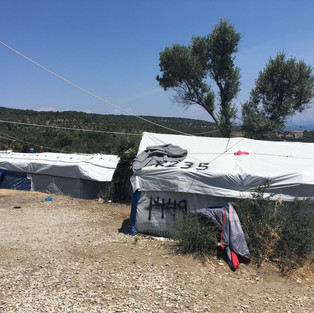The Border Cuts as Deep as a Bullet
- Jul 4, 2018
- 3 min read
Updated: Apr 16, 2020
Evie Papada | 4 July 2018

Events around the world today prompt us to rethink the meaning and significance of #borders. Is globalization making borders disappear, as some would argue, and if so, how come we are confronted with images and discourses of border enforcement, particularly in Europe and the US? As part of my doctoral research, I am prompted to reflect on the nature of today’s border enforcement practices and its consequences.
I spent several weeks in one of Europe’s emerging spaces of border control and care, the island of #Lesbos in the eastern Aegean. In addition to the regular inhabitants, the island is home to 10000 #asylum seekers, nearly 7000 humanitarian workers and border activists, including personnel of International and EU organizations. It is a stunning equation, for no matter how well care is financed, the suffering continues to grow. Since March 2016 when the bilateral agreement on #migration management with neighboring Turkey came to force, all those who arrive in Lesbos are subjected to a geographical restriction: they are not to move beyond the island, for the duration of the completion of asylum process. As a result, living conditions in EU sponsored camps are exacerbated. Scholars and others point to the fact that unauthorized border crossings have become a matter of life and death and that Europe’s image as a space of protections is weaning due to practices of containment and abjection. A particular disconcerting aspect of EU border policies of #containment is the growing suicide rates amongst asylum seekers, including an epidemic of post-traumatic stress disorder among children who reside in the new border spaces. As a doctor from the medical organization MSF put it, the border cuts as deep as a bullet.
From Left to right: 1. Moria Hotspot, South Side. Information waiting zone; 2. MSF paediatric clinic outside Moria; 3. UK Border Force vessel 'valiant', operating in the area for three years; 4. and 5. perspectives of Moria, the hotspot reception and identification centre
Within the past two years several actors operating in Lesbos have drawn a direct link between border enforcement and migrant vulnerability. The point made is that despite EU’s humanitarian rhetoric of saving lives and caring for the most vulnerable, the reality on the ground suggests that border policies in fact expose migrants to violence, augmenting rather than addressing vulnerabilities. This realization is at odds with legal and procedural provisions and guarantees embedded both within the European Common Asylum System and Greek asylum legislation. In both, categories of vulnerability are assigned to applicants according to their age, gender, experiences of trauma, victims of torture, Sexual and Gender Based Violence (SGBV) or FGM. In theory, identification of vulnerability is set as a priority and advice and training is provided to asylum case workers, care personnel and the coast guard patrol officers in ‘spotting’ the vulnerable migrant early enough in the long and complex process of border registration, nationality identification and refugee status determination. Within the newly reconfigured asylum process on the Aegean islands dubbed as ‘migrant hotspots’ navigating through these processes becomes challenging for asylum seekers and legal aid personnel alike; there exist separate avenues for processing asylum claims, some quicker other slower, and the applicants’ nationality and assessment of #vulnerability become decisive factors in this relation, adding to the much-criticized trend of fragmenting the asylum system. In this context, the designation of vulnerability signifies more than access to special procedural guarantees and adequate treatment. In most cases, it provides adequate grounds for their claims to be processed under the regular asylum process, not on the islands, but in mainland Greece. It also offers access to better accommodation options, in furnished apartments away from the overcrowded Reception and Identification center known as Moria. The question of who decides and at which point within the process, who and how can influence that decision, what actions follow the designation of vulnerability form a space of contestation and negotiation among case workers, humanitarian actors and migrant themselves. Alas, the notion of vulnerability is read as a personal characteristic, a condition specific to an individual due to his or her belonging to a category or acquired within the migratory process and not as stemming from environmental factors, namely the appalling conditions created within processes of border enforcement.
An understanding of how the border makes vulnerable and what vulnerability means in relation to border crossing require us to rethink the idea of borders in relation to the #biopolitical practices that seek to produce hierarchies of protection, while restricting freedom of #movement.














Comments